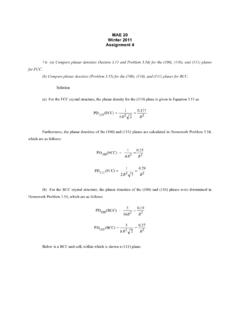Transcription of WIND TUNNEL EXPERIMENTAL PROCEDURE
1 MAE 175A Wind TUNNEL Experiment (K. Seshadri) Written by Cattolica, modified by Tynan 1/10/2014 11 WIND TUNNEL EXPERIMENTAL PROCEDURE MAE 175A PART I Pressure Distribution over an airfoil and Drag by the wake survey method OBJECTIVE: Measure the pressure distribution over a Clark Y-14 Airfoil at various angles of attack and determine the drag coefficient of the wing by the wake survey method. Data are obtained up to and beyond the stall angle, where the flow separates from the upper surface of the airfoil. INTRODUCTION: An airfoil develops Lift through generally lower pressures above the wing and higher below with respect to the pressure of the approaching air. In addition, the Lift force increases with higher angle of attack up to a critical angle. Beyond this critical angle the lift force decreases significantly and the wing is said to have stalled . The overall pressure distribution can be measured with small tubes embedded in the wing leading to a suitable pressure transducer.
2 The laboratory model is equipped with 18 pressure openings. The openings are located at 0, , 10, 20, 30, 40, 50, 60 and 70 percent chord on both upper and lower surfaces and there is an additional opening at 80 percent chord on the upper surface. To complete the pressure distribution you should extrapolate the last measurements on the upper and lower surfaces of the wing to a pressure coefficient of Cp=0 at the trailing edge of the wing. Application of the momentum principle indicates that the drag force on an airfoil in the flow should be equal to the reduction in linear momentum of the flow (in the drag direction) provided that the measuring stations are taken where the static pressures are substantially equal. Since the flow approaching the airfoil is uniform, the drag coefficient may be written in terms of a downstream wake survey (as developed in Ref. 1): Cd=Ywc 1q cq dy Yw2Yw2 where: Yw = width of wake q = local dynamic pressure q = free stream dynamic pressure It is recommended that the wake survey be made as far from the trailing edge as possible to render the static pressure effects negligible.
3 Students may find that the wake field drag coefficient obtained in the stalled configuration disagrees with other drag measurements, and MAE 175A Wind TUNNEL Experiment (K. Seshadri) Written by Cattolica, modified by Tynan 1/10/2014 22they should examine the assumptions made in the momentum balance analysis in order to identify which of these assumptions are violated by the flow over a stalled airfoil. This method of drag measurement is often used on portions of airplane wings in flight to test special drag profiles or surface treatments. The pitching moment can also be obtained from the chordwise pressures by use of (Ref. 1) CmLE=1c2 Pq ( x) dc where:x = distance from leading edge (or other selected reference point). PROCEDURE : 1. Using the barometer and thermometer in the laboratory determine the density of the air flowing in the wind TUNNEL . 2. Using the Wing TUNNEL Calibration VI calibrate the wind TUNNEL test section by generating a plot of velocity (m/sec) versus motor frequency (0- 60 Hz) using the upstream pitot-static tube and Bernoulli's equation.
4 Please see Wind TUNNEL Laboratory Notes: week 1 for details. U Static pressureFreestream Pressure- 1 hba Pitot Probe: Measurement of Airspeed Pa+12 aUa2=Pb+12 bUb2 where: Ua=0 and Ub=U Pa Pb=12 U 2=q or Pa Pb= 1 hge and: MAE 175A Wind TUNNEL Experiment (K. Seshadri) Written by Cattolica, modified by Tynan 1/10/2014 33U =2(Pa Pb) 1/2 or U =2 1 h ge 1/2 3. Use standard propagation of error analysis to estimate the error in U . Y=f(xi) Y= f xi 2 xi2( )1i 12 4. A pressure wing is mounted vertically in the wind TUNNEL . The pressure tubes (18 with locations indicated in the Appendix) from the wing are connected to the inlet nipples of the TUNNEL pressure transducer array sampling system. The static pressure of the test section is connected to the reference connection of the pressure transducer. The dynamic pressure of the air stream q is measured with the Pitot probe.
5 Dividing the pressure measured with the sampling system by q gives the pressure coefficient at the point of the measurement: Cp=P Prefq 5. Operate the TUNNEL at airspeeds of 20, 35 and 50 m/sec and make pressure measurements on the wing at angles of attack of 0 , 4 , 8 , 12 , and 16 . Please see Wind TUNNEL Laboratory Notes: week 2 for details. Always check the zero velocity pressure measurements from the wing and pitot probe before each data set. You will need to measure and correct for any offsets in the pressure transducer at zero velocity. Results: 1. Plot the pressure coefficient data points (upper and lower surface) as a function of distance along the chord line of the wing and integrate to find the Normal Force coefficient Cn which is given as Cn=1c(CpL CpU)dx0c . Find this normal force coefficient for all angles of attack and flow speeds. 2. Determine the Lift coefficients CL from CN and Plot CL vs.
6 For each air-speed. Show the results on one graph for comparison purposes. 3. On a separate graph plot Cd vs. for each air-speed. Note that this method does not measure drag viscous forces due to shear stresses and thus may under represent the total drag force on the wing. The drag force and drag coefficient measured in this experiment is the component of the normal force in the direction parallel to the free stream flow, and increases as the angle of attack increases. MAE 175A Wind TUNNEL Experiment (K. Seshadri) Written by Cattolica, modified by Tynan 1/10/2014 44 4. Using the equation for the pitching moment Cmref=1c2(CpU CpL) (x xref) dx0c a) Calculate the leading edge pitching moment CM LE for the airfoil as a function of angle of attack for each velocity and present the results in a table. b) Calculate the center of pressure for the airfoil as a function of angle of attach for each velocity and present the results in a table. Xcpc= CMLECN c) Calculate the pitching moment through the quarter chord point as a function of angle of attack for each velocity and present the results in a table.
7 5. a). Operate the TUNNEL at airspeeds of 20, 35 and 50 m/sec and obtain wake pressure survey measurements in the wake of the vertically mounted pressure wing at angles of attack of 0 , 4 , 8 , 12 , and 16 . Always check the zero velocity pressure measurements from the wing and pitot probe before each data set. You will need to measure and correct for any offsets in the pressure transducer at zero Note: At the smaller angle of attack values ( up to about 8 degrees, the available rake can adequately cover the entire wakefield adequately. However, at a higher angle of attack, the rake may not completely cover the wake. In order to correctly measure the wakefield at these extreme values, you will need to displace the rake both above and below the airfoil. Please see the TA, Professor, or Technician for assistance for the highest angles of attack wakefield measurement setup) b) Plot the normalized wake survey pressure distribution q/q versus distance across the wake for each angle of attack for the three different velocities.
8 C) Calculate the drag coefficient for the airfoil by the momentum method by integrating the wake presurre distribution for each angle of attack and the three velocities. Plot this drag coefficient versus angle of attack for each of the flow velocities used in the experiment, and compare this result to the drag force computed in part 3 above. Make sure to comment on any differences or discrepancies in the two different drag estimates. 6. Determine the effect of Reynolds Number on lift, drag, and 1/4 cord pitching moment coefficients. (Plot the lift and pitching moment coefficient from the pressure wing measurements, and the drag coefficient from the wake measurements versus Reynolds number for all available angle of attack.) MAE 175A Wind TUNNEL Experiment (K. Seshadri) Written by Cattolica, modified by Tynan 1/10/2014 55 PART II CHARACTERISTIC CURVES OF A CLARK Y-14 AIRFOIL OBJECTIVE: Measure the Lift, Drag and Pitching Moment of a Clark Y-14 airfoil.
9 DISCUSSION: The Clark Y-14 airfoil profile is unusual in that its lower surface is straight and is taken as its chord line. The angle of attack can consequently be checked with an inclinometer contacting the lower surface. The lift, drag, and pitching forces on the airfoil can be calculated from a force balance measurements of the axial force A', normal force N', and pitching moment P' relative to the sting support on the balance. The values of A', N', and P' are measured from strain gauge bridges on the force balance and are not independent. They interact because of mechanical coupling and deformation of the balance and must be corrected. To compensate for this interaction between the measured values, the following set of equations can be used to provided corrected values of axial force A, normal force N, and pitching moment P: N = N'*.9504-A'*.0082-P'* A = N'*.0608+A'*.5912 P= -N'*.1336+A'*.0119+P'* Using the corrected values of axial force A and normal force N the lift and drag can be calculated from the relations: Lift = N cos - A sin Drag = A cos + N sin For conversion to lift, drag, and pitching moment coefficients the wing has a span width b= " and a chord length of c = ".
10 MAE 175A Wind TUNNEL Experiment (K. Seshadri) Written by Cattolica, modified by Tynan 1/10/2014 66 PROCEDURE : 1. Using the adjustment on the drag balance set the angle of attack to zero with the chord line horizontal as determined by inclinometer. 2. Check that the normal and axial force and moment output of the drag balance is zero with no airspeed and at zero angle of attack. 3. With no airspeed operate the drag balance through a range of angle of attack from -6o to 20o and record the normal and axial force and the momentum output. The weight of the wing will affect some of these measurements and will need to be included in corrected measurements. 4. Using the labview Sting VI, operate the TUNNEL at airspeeds of 20, 35 and 50 m/sec. Please see Wind TUNNEL Laboratory Notes: week 3 for details. 5. Starting at an angle of attack of -4 , for a given airspeed, take readings of Normal Force, Axial Force and Pitching Moment at 2 intervals to 4 beyond the stall.






